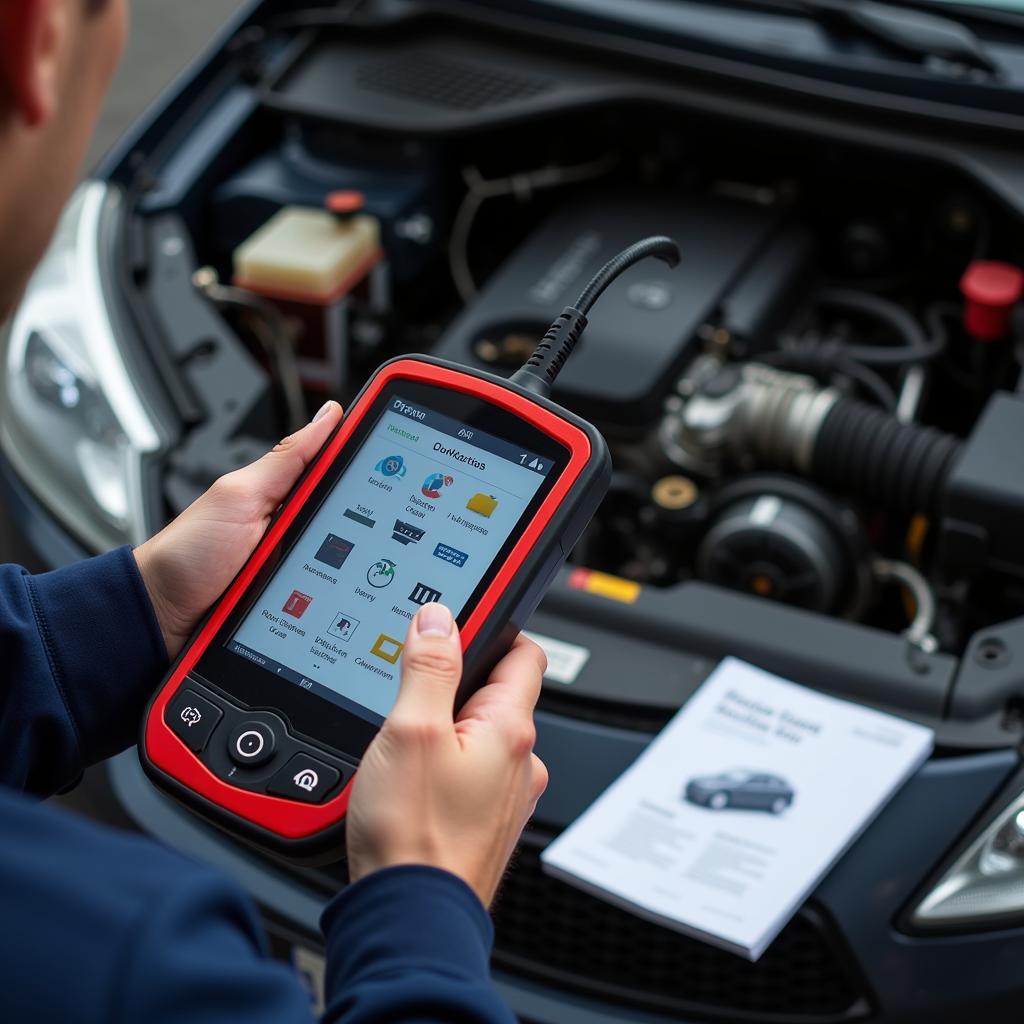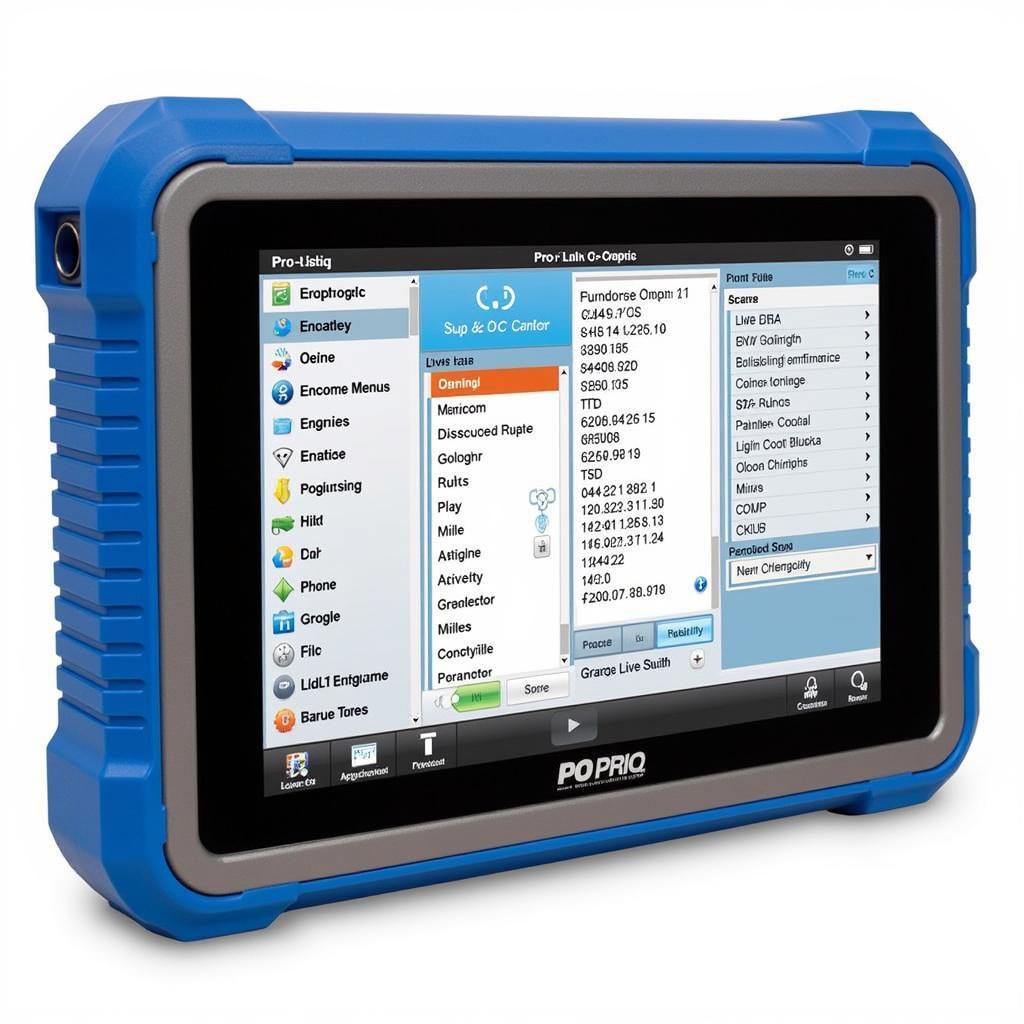A malfunctioning Manifold Absolute Pressure (MAP) sensor can cause a variety of performance issues in your vehicle. Instead of taking your car straight to a mechanic, you can use a scan tool to diagnose the problem yourself. This guide will walk you through the process of checking your MAP sensor with a scan tool and help you understand the readings.
What is a MAP Sensor and How Does it Work?
Before we dive into the diagnostics, let’s understand the basics. The MAP sensor is a critical component of your car’s engine management system. It measures the pressure inside the intake manifold, which directly reflects the engine load.
Think of it this way: when you press the accelerator, the engine needs more air. The MAP sensor detects this change in pressure and sends a signal to the Engine Control Unit (ECU). The ECU then adjusts the fuel injection and ignition timing accordingly, ensuring optimal engine performance.
Symptoms of a Failing MAP Sensor
A failing MAP sensor can manifest itself in a number of ways. Here are some common symptoms to look out for:
- Check Engine Light: One of the first indicators is often the dreaded “check engine” light illuminating on your dashboard.
- Rough Idle: Your engine might idle erratically or roughly due to inaccurate fuel-air mixture readings.
- Reduced Fuel Economy: A faulty MAP sensor can disrupt the fuel-air ratio, leading to decreased fuel efficiency.
- Hesitation or Stalling: You might experience hesitation or stalling during acceleration as the engine struggles to receive the correct fuel supply.
- Black Smoke from Exhaust: Black smoke coming from your car’s exhaust can indicate a rich fuel-air mixture, often caused by a malfunctioning MAP sensor.
Gathering the Necessary Tools
Before you begin the diagnostic process, you’ll need a few essential tools:
- Scan Tool: This is the primary tool for reading the MAP sensor data. Choose a scan tool that’s compatible with your vehicle make and model.
- Repair Manual: A repair manual specific to your car will provide valuable information about sensor location, wiring diagrams, and specific diagnostic procedures.
 Tools for Checking MAP Sensor
Tools for Checking MAP Sensor
Checking MAP Sensor Voltage with a Scan Tool: A Step-by-Step Guide
Now, let’s delve into the actual process of checking your MAP sensor using a scan tool.
- Locate the MAP Sensor: Consult your repair manual to identify the location of the MAP sensor in your vehicle. It’s typically situated on the intake manifold or firewall.
- Connect the Scan Tool: Turn off your vehicle’s ignition and connect the scan tool to the OBD-II port. This port is usually located under the driver’s side dashboard.
- Turn on the Ignition: Turn the ignition key to the “on” position without starting the engine. This powers up the scan tool and allows it to communicate with your car’s ECU.
- Access Live Data Stream: Navigate through the scan tool’s menu to find the “live data stream” or “sensor readings” option.
- Select MAP Sensor Reading: Look for the parameter related to the MAP sensor. It might be labeled as “MAP,” “Manifold Absolute Pressure,” or something similar.
- Observe the Voltage Reading at Idle: With the engine off, the MAP sensor voltage should typically read around 4.5-5 volts. This indicates the sensor is receiving the correct reference voltage from the ECU.
- Start the Engine: While monitoring the scan tool, start the engine and let it idle.
- Check Voltage at Different RPMs: As you increase the engine RPM, the voltage reading on the scan tool should also increase proportionally. The voltage should rise smoothly without any sudden drops or spikes.
- Compare Readings with Specifications: Consult your repair manual for the specific voltage range for your MAP sensor at different engine speeds.
Interpreting the Results
Analyzing the MAP sensor voltage readings can help you determine the sensor’s health. Here’s what the readings indicate:
- Steady Voltage at Idle: A steady voltage around 4.5-5 volts at idle generally indicates a properly functioning MAP sensor.
- Fluctuating Voltage at Idle: If the voltage fluctuates erratically at idle, it suggests a potential issue with the sensor itself or the wiring.
- No Voltage Change with RPM: If the voltage reading doesn’t change as you increase the engine speed, it indicates a problem with the sensor’s ability to detect pressure changes.
- Voltage Out of Range: Voltage readings consistently outside the manufacturer’s specifications point towards a faulty MAP sensor that needs replacement.
Expert Insight:
“Remember, a scan tool is a powerful diagnostic tool, but it’s essential to interpret the readings correctly,” says John Miller, Senior Automotive Technician at Miller’s Auto Repair. “If you’re unsure about the readings or suspect a MAP sensor issue, it’s always wise to consult a qualified mechanic.”
Common MAP Sensor Issues and Troubleshooting Tips
Several factors can contribute to MAP sensor problems. Here are some common culprits and potential troubleshooting steps:
- Vacuum Leaks: A leak in the vacuum lines connected to the MAP sensor can disrupt pressure readings. Inspect the vacuum hoses for cracks, loose connections, or damage.
- Wiring Problems: Damaged or corroded wiring to the MAP sensor can interrupt the signal transmission. Check the wiring harness for any signs of wear and tear.
- Clogged MAP Sensor Port: Dirt, debris, or carbon buildup can obstruct the MAP sensor port, affecting its accuracy. Carefully clean the port using a can of compressed air.
- Faulty MAP Sensor: Over time, the MAP sensor itself can wear out or fail. If other troubleshooting steps don’t resolve the issue, replacement is likely necessary.
Expert Tip:
“When replacing a MAP sensor, always use a high-quality OEM (Original Equipment Manufacturer) or equivalent part to ensure compatibility and optimal performance,” advises Sarah Thompson, ASE Certified Master Technician.
Conclusion
Checking your MAP sensor with a scan tool is a relatively straightforward process that can save you time and money. By understanding how to interpret the readings and troubleshoot common issues, you can take proactive steps to maintain your vehicle’s engine performance.
If you encounter persistent issues or are uncomfortable performing these checks yourself, don’t hesitate to reach out to the experts at ScanToolUS. We’re here to assist you with all your automotive diagnostic needs. You can reach us at +1 (641) 206-8880 or visit our office at 1615 S Laramie Ave, Cicero, IL 60804, USA.
Frequently Asked Questions (FAQs)
1. Can a bad MAP sensor cause my car not to start?
While a severely malfunctioning MAP sensor can make starting difficult, it’s less likely to prevent starting altogether. Other components like the crankshaft position sensor play a more direct role in the starting process.
2. How much does it cost to replace a MAP sensor?
The cost of replacing a MAP sensor can vary depending on the make and model of your vehicle. Typically, you can expect to pay between $50 to $200 for the sensor itself, with labor costs ranging from $50 to $150.
3. Can I clean my MAP sensor?
Yes, you can try cleaning the MAP sensor using a specialized electronic cleaner or MAF sensor cleaner. However, if cleaning doesn’t resolve the issue, replacement is often the best course of action.
4. How long does a MAP sensor last?
The lifespan of a MAP sensor can vary depending on driving conditions and vehicle maintenance. On average, they can last anywhere from 75,000 to 100,000 miles.
5. Can I drive with a bad MAP sensor?
While you might be able to drive short distances with a malfunctioning MAP sensor, it’s not advisable. Driving with a faulty sensor can lead to reduced fuel economy, increased emissions, and potential damage to other engine components.


Pingback: Scan Tool Says Reading Fail: Troubleshooting Common Causes and Solutions - Car Scan Tool